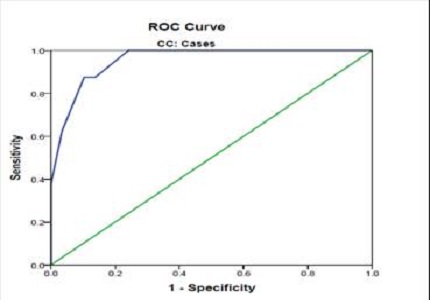Predictive value of umbilical cord blood bilirubin and albumin for significant hyperbilirubinemia in ABO incompatibility
Abstract
Introduction: ABO incompatibility is the most common cause of hemolytic disease of the newborn with approximately 15% of live births at risk. The objective of this study wasto estimate the levels of bilirubin and albumin in cord blood and determine their relationship with the occurrence of neonatal hyperbilirubinemia in ABO incompatibility.
Methods: Design: Prospective study.
Study settings: Raja Mirasudhar Hospital, Thanjavur.
Participants: Healthy term neonates (n-92) born to O+ve mothers.
Control: neonates (n-55) with blood group O+ve. Case:neonates (n-37) with blood group A+ve orB+ve.
Procedure: Umbilical cord blood was collected from newborns and serum albumin and bilirubin levels estimated. The babies were followed-up daily for development of jaundice and serum bilirubin was measured in all newborns at 24 and 72 hours of life.
Result: The mean serum total bilirubin and albumin in umbilical cord blood were 1.596+0.46 mg/dland 3.587 + .65g/dl in control group and 1.995+1.16 mg/dl and 3.559 + .64g/dl in case group respectively. Umbilical cord serum albumin level of< 3.15 g/dl predicts the development of significant hyperbilirubinemia with a sensitivity of 76.5%, specificity of 78.7% and an accuracy of 77.6%. Umbilical cord serum total bilirubin of >1.85 mg/dl predicts the development of significant hyperbilirubinemia with a sensitivity of 70.6%, specificity of 82.7% and an accuracy of 76.7%.
Conclusion: In ABO blood group incompatibility, neonates with umbilical cord blood total bilirubin >1.85 mg/dl and albumin <3.15 g/dl need close follow up to watch for development of significant hyperbilirubinemia while those babies with umbilical cord total bilirubin <1.85 mg/dl and albumin>3.15 g/dl can be safely discharged early.
Downloads
References
2. Serious Reportable Events in Healthcare – 2011 update: a consensus report. Washington DC: National Quality Forums;2011.
3. Radmacher P, Massey C, Adamkin D. Hidden morbidity with "successful" early discharge.J Perinatol. 2002 Jan;22(1):15-20. DOI: 10.1038/sj.jp.7210586. [PubMed]
4. Kiely M, Drum MA, Kessel W. Early discharge. Risks, benefits, and who decides.Clin Perinatol. 1998 Sep;25(3):539-53, vii-viii.
5. American Academy of PediatricsSubcommittee on Hyperbilirubinemia.Management of hyperbilirubinemia in the newborn infant35 or moreweeks of gestation.Pediatrics. 2004 Jul;114(1):297-316. [PubMed]
6. Zeitoun AA, Elhagrasy HF, Abdelsatal DM. Predictive value of umbilical cord bloodbilirubin in neonatal hyperbilirubinemia.Egyptian Pediatric Association Gazette. 2013Jan;61(1):23-30.doi:10.1016/j.epag.2013.04.006.
7. Aljabri MM, Khoogh FF, Alsolimani SA, Saleh IH, Alshehri IA, Alshehri MM. Effectiveness of cord blood albumin as a predictor of neonatal jaundice. Int J Health Care Sci. 2015Oct;3(2):340-2.
8. Hamdi N, Elgayar A, Salah MH. Cord blood bilirubin as a predictor of neonatalhyperbilirubinemia. Med J Cairo Univ. 2012Jun;80(2):31-6.
9. Taksande A, Vilheker K, Jain M, Zade P, Atkari S, Verkey S. Predictionof the development of neonatal hyperbilirubinemia by increased umbilical cord blood bilirubin. CurrPediatr Res. 2005Jul;9(1&2):5-9.
10. Rostami N, Mehrabi Y, Asadzadeh F. Identifying the newborns at risk for developing significant hyperbilirubinemia by measuring cord bilirubin levels. J Arab Neonatal Forum. 2005;2:81-5.
11. Bernaldo AJ, Segre CA.Bilirubindosage in cord blood: could it predictneonatal hyperbilirubinemia?Sao Paulo Med J. 2004 May 6;122(3):99-103. Epub 2004 Sep 16. [PubMed]
12. Nahar Z, Shahidulla, Mannan A, Dev SK, Mitra U, Sellimuzaman SM. The value of umbilical cord blood bilirubin measurement in predicting the development of significant hyperbilirubinemia in healthy newborn. Bangladesh J Child Health.2010Aug;33(2):50-4.doi:10.3329/bjch.v33i2.5677.
13. Venkatamurthy M, Murali SM, Mamathy S. A comparison study; cord serum albumin is compared with cord serum bilirubin as a risk indicator in predicting neonatal jaundice. Journal of Evolution of Medical and Dental Sciences. 2014Apr;4017-22.doi:10.14260/jemds/2014/2393.
14. Sandeepkumar, Manjunath GA, Ajay J, Reddy S. Low cord serum albumin is a risk indicatorin predicting neonatal jaundice. IOSR Journal of medical and dental sciences. 2016 Oct;15(10):76-8.doi: 10.9790/0853-1510017678.
15. Sahu S, Abraham R, John J, Mathew MAA, George A. Cord blood albumin as a predictor of neonatal jaundice. Int J Biol Med Res.2011;2(1):436-8.

Copyright (c) 2018 Author (s). Published by Siddharth Health Research and Social Welfare Society

This work is licensed under a Creative Commons Attribution 4.0 International License.


 OAI - Open Archives Initiative
OAI - Open Archives Initiative


